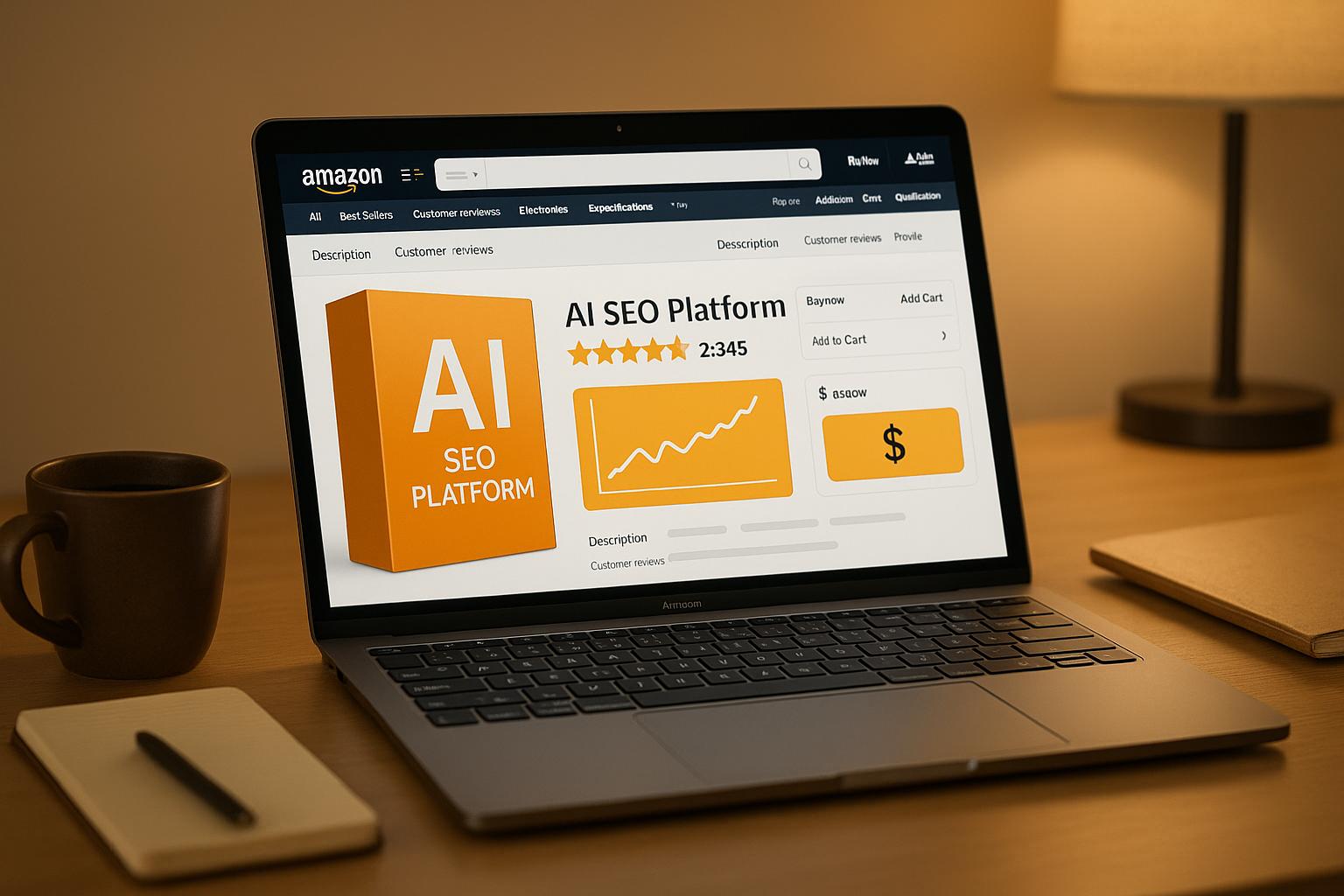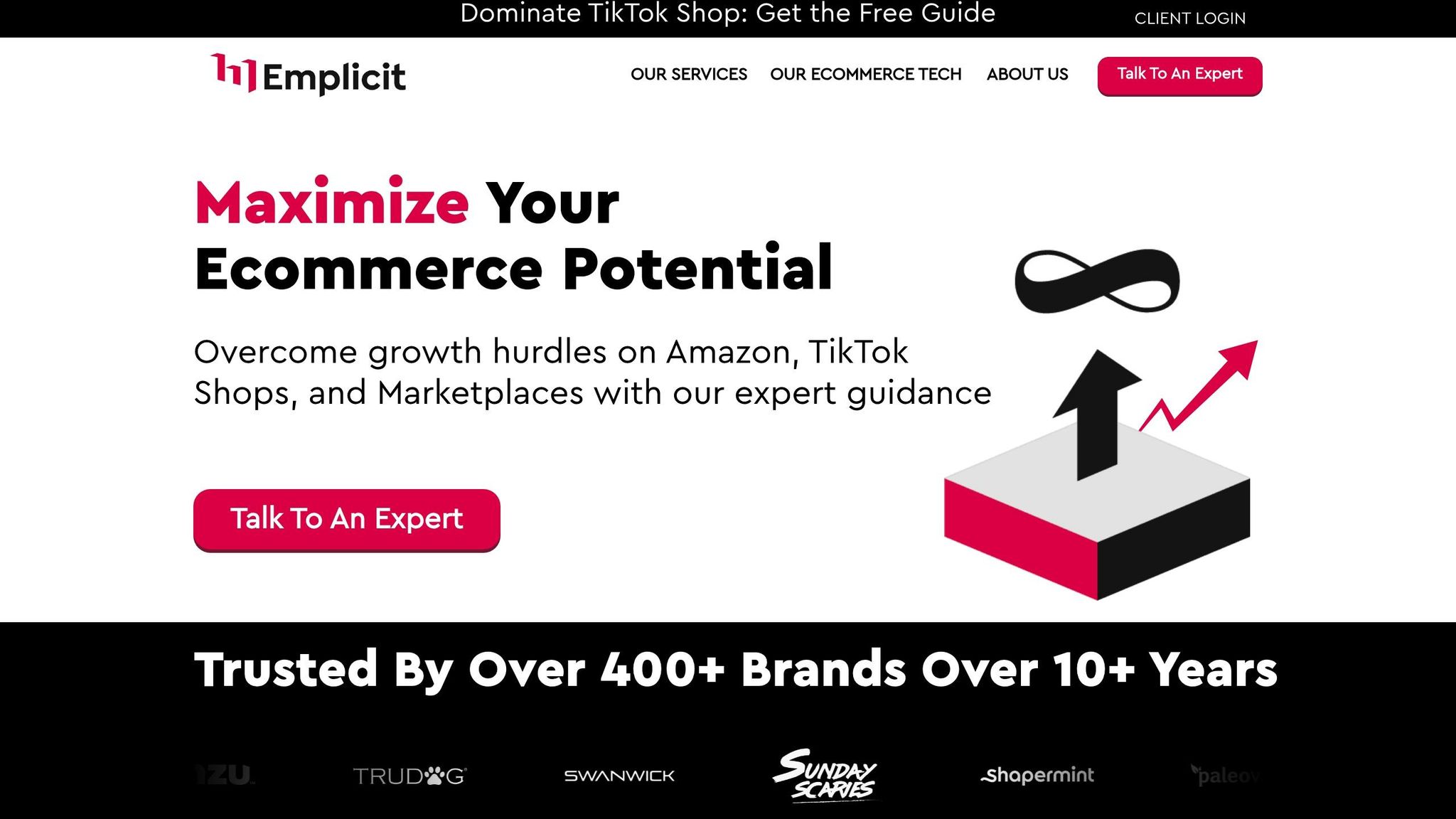
AI-powered Amazon SEO platforms are transforming how sellers optimize product listings. These tools automate keyword research, improve search rankings, and adapt to Amazon’s unique algorithms. With over 60% of online shoppers starting their journey on Amazon, optimizing product visibility is critical. Key features of these platforms include:
- AI-Driven Keyword Research: Identifies high-intent and long-tail keywords.
- Automated Listing Optimization: Enhances product titles, descriptions, and A+ Content.
- Performance Analytics: Tracks rankings, conversions, and competitor data.
- Predictive Insights: Forecasts trends and customer behavior.
- Automated Monitoring: Updates listings and pricing based on real-time data.
Amazon’s integration of AI tools has already helped sellers improve listing quality by 40%, with 90% of sellers accepting AI-generated content with minimal edits. By leveraging these platforms, sellers can increase visibility, boost conversions, and stay competitive in a crowded marketplace.
How to Optimize Amazon Listings with AI in Seconds: a Guide to Using AI Listing Builder

Main Features of AI Amazon SEO Platforms
AI-powered Amazon SEO platforms have completely reshaped how sellers optimize their product listings. These tools go far beyond basic keyword matching, providing a range of advanced features that help sellers make smarter decisions to boost visibility, conversions, and overall performance. Let’s break down some of their standout capabilities.
AI-Powered Keyword Research
Gone are the days of spending hours manually analyzing keywords. AI platforms now handle this process with remarkable efficiency, uncovering insights that would be nearly impossible to find without automation. By examining vast datasets, these tools pinpoint the exact phrases customers use when searching for products, including long-tail keywords that are often overlooked.
For instance, one platform boasts a keyword database of over 200 million entries, with daily searches exceeding 1,000 – an indicator of its effectiveness in meeting user needs. These tools excel at identifying long-tail keywords, which often face less competition and lead to higher conversion rates. Features like reverse ASIN analysis allow sellers to study competitor strategies by identifying the keywords driving traffic to successful products. Additionally, keyword tracking tools monitor search volume and conversion rates over time, enabling sellers to refine their strategies based on trends or seasonal shifts. Some platforms even extend their capabilities to global marketplaces, analyzing keywords in multiple languages and accounting for common typos.
Automated Listing Optimization
AI-driven listing optimization takes the guesswork out of creating high-performing product pages. These platforms analyze successful listings to understand what drives conversions, then apply those insights to optimize titles, descriptions, and other elements. It’s not just about stuffing listings with keywords – it’s about making them resonate with both Amazon’s algorithms and human shoppers.
One example highlights a company that identified 37 long-tail keywords, leading to a 24% boost in organic traffic and an 18% increase in sales within just two months. These tools also anticipate seasonal trends, as seen with a phone accessories brand that restructured its listings six weeks before the holiday rush, resulting in a 43% year-over-year sales increase in Q4 – all without additional ad spend. Another feature, inventory-aware optimization, aligns keyword strategies with stock levels. A dog toy brand, for example, focused on fully stocked products, improving catalog performance despite inventory challenges.
Performance Analytics and Data Insights
AI platforms don’t just gather data – they turn it into actionable insights. Real-time performance metrics, displayed through intuitive charts and graphs, help sellers track keyword rankings and measure the effectiveness of their strategies. These insights allow for smarter, data-driven decisions.
Take the case of a kitchen accessories brand that improved the organic ranking of its top 20 keywords by an average of 6.3 positions. This, combined with better inventory management and pricing strategies, boosted their profit margins by 11%. Integration with Amazon Seller Central ensures seamless access to accurate data, while multi-marketplace analytics provide a unified dashboard for monitoring performance across different channels. Considering that 75% of Amazon shoppers never scroll past the first page, these insights are crucial for staying competitive. By incorporating these analytics into daily workflows, sellers gain a significant edge in improving their listings and overall performance.
Setting Up AI Amazon SEO Platforms
Here’s how to get your AI platform ready to optimize Amazon SEO effectively from the beginning.
Account Setup and Integration
Start by linking your AI platform to your Amazon Seller Central account. Generate API keys within Seller Central and use them to sync your product listings. During this process, set your primary marketplace (Amazon.com), currency (USD), and user permissions. This integration ensures your data stays accurate and your workflow becomes more efficient.
Once connected, configure essential settings like marketplace preferences and team access levels. Assign permissions to ensure everyone on your team has the right level of access to the platform.
Keyword Research and Data Import
With your account integrated, shift your focus to keyword research. Import your product data and let the platform’s AI analyze search volume, competition, and competitor listings to identify long-tail keywords that could boost your visibility.
Many platforms also support reverse ASIN analysis. By inputting competitor product IDs, you can uncover the keywords driving their success. Organize these keywords by product category to simplify performance tracking and streamline your optimization efforts.
Setting Benchmarks and Performance Tracking
After importing your data and refining your keyword strategy, it’s time to set benchmarks. Use Seller Central’s Business Reports to document current metrics like conversion rates, unit session percentages, and customer return rates. These will serve as your baseline.
Create standardized reports that include key metrics, top-performing keywords, competitor insights, and SEO health scores. Regular reporting helps you track trends and share progress with your team or stakeholders.
Set realistic yet ambitious goals based on data, business priorities, and industry trends. For example, you might focus first on best-selling products or items tied to upcoming shopping seasons. Use these goals to guide your optimization strategy.
Make it a habit to monitor keyword rankings, traffic, and conversions through your reports. This will help you quickly identify shifts in performance and adjust your approach as needed.
sbb-itb-e2944f4
Advanced Features and Automation
Going beyond basic optimization, advanced AI tools provide sellers with the ability to automate key tasks and implement forward-thinking strategies. These AI-driven Amazon SEO platforms include powerful features that can reshape how you manage your business, saving time and helping you stay ahead of market trends.
AI-Driven Listing Creation
With AI-powered tools, creating product listings becomes a breeze. These systems generate optimized titles, bullet points, and descriptions by analyzing top-performing listings in your category. They align with Amazon’s algorithm preferences while keeping the language natural and appealing to customers, which boosts conversions. By factoring in keyword density, character limits, and semantic relevance, these tools craft listings designed to rank higher and convert better.
Predictive Analytics for Market Trends
AI algorithms dive deep into historical sales data, customer behavior, and external factors to forecast demand and identify emerging trends. They even use sentiment analysis to evaluate customer reviews and keep an eye on competitors’ listings, pricing, and promotions. For example, one outdoor gear seller leveraged AI to spot a growing interest in camping equipment, leading to the launch of a camping stove that became a bestseller. Similarly, a fashion merchant used seasonal forecasts to fine-tune inventory levels, cutting down on overstocks and boosting profitability. These predictive insights help sellers make smarter decisions about product launches, inventory, and marketing.
On top of these forecasts, automation ensures your listings evolve with market changes.
Automated Monitoring and Updates
Advanced AI platforms continuously monitor your listings, tracking keyword rankings, competitor pricing, inventory levels, and customer feedback to keep performance on track. Since 80% of purchases on Amazon come from the top 10 search results, maintaining those positions is crucial. Automated tools adapt your listings to algorithm updates, competitive shifts, and changing consumer behavior.
Dynamic pricing tools, for instance, adjust prices based on real-time competitor data and demand fluctuations, increasing revenue by 8–20%. AI also predicts demand to avoid stockouts and overstocks, often improving profit margins by 10–25% while reducing labor costs by up to 40%. Automated competitor analysis further enables quick responses to threats and uncovers new market opportunities. These features not only streamline routine tasks but also free you up to focus on growth strategies – some sellers have scaled their Amazon stores from $10,000 to over $100,000 in monthly revenue within just 12–18 months.
Emplicit‘s Amazon SEO Services

Emplicit offers a personalized service designed to help US sellers achieve outstanding Amazon SEO results. As an accredited Amazon Partner, they manage over $550 million in sales and oversee more than 40,000 products, making them a trusted choice for comprehensive Amazon SEO services.
Emplicit’s Full-Service Approach
At the heart of Emplicit’s strategy is their 4D plan: Diagnose, Design, Deploy, and Dominate. This structured method ensures every part of your Amazon presence is optimized to boost visibility and drive sales. Their team covers the full range of Amazon optimization services, including PPC management, listing optimization, inventory management, and account health monitoring.
Emplicit understands that success on Amazon hinges on creating a seamless customer experience – from the moment a shopper searches for a product to the post-purchase phase. Their Customer Solutions team actively manages customer reviews, both positive and negative, to help brands build strong reputations and foster long-term growth.
They also excel at creating A+ Content, which can boost sales by up to 20%. By crafting enhanced brand content, they not only improve keyword exposure but also educate customers and build trust between brands and their audiences. This comprehensive approach sets the stage for leveraging AI to achieve measurable growth.
Using AI for Business Growth
Emplicit combines AI-driven insights with experience managing over $100 million in ad spend to optimize listings according to Amazon’s A9 and A10 algorithms. With nearly 200 million people searching for products on Amazon each month, securing a spot in the top eight search results is critical.
Their strategies focus on in-depth keyword research to target both high-volume and long-tail keywords, driving traffic and conversions. This approach positions brands to capture the 45% of traffic that goes to first-page listings while staying competitive in their categories.
The results are impressive. For example, AllGood, a global consumer health solutions company, saw its monthly revenue grow fivefold – from $35,000 to $165,000 – in just three months using Emplicit’s methods. Similarly, Trtl Travel achieved fourfold growth in one year, taking their $3 million brand to new heights with Emplicit’s 4D plan and custom roadmap.
Custom Strategies for US Sellers
Emplicit recognizes that every brand is different. They tailor their services to meet the unique needs of US-based sellers, whether it’s helping smaller brands establish themselves or scaling operations for larger companies.
"We understand we’re not only helping you sell your product. We’re also helping you sell your brand." – Emplicit
This philosophy guides their approach to case management with Amazon, ensuring all content reflects the brand’s identity while maximizing search visibility. Emplicit also extends their expertise beyond Amazon, providing marketing support through Google Search, Google Shopping, Facebook, and other platforms. They use Amazon Attribution to test marketing channels without impacting existing sales.
Their long-term partnerships speak volumes. For instance, they worked with Just Thrive, a digestive and immune health provider, for four years, achieving 2x total growth and maintaining 20% year-over-year growth. This commitment to sustained performance demonstrates how Emplicit’s custom strategies evolve alongside their clients as they grow in the marketplace.
Conclusion
AI-powered platforms are transforming the way sellers approach Amazon SEO. These tools not only automate time-consuming tasks but also provide insights that go far beyond what manual analysis can achieve. For sellers who adopt this technology, the results speak for themselves.
Main Benefits of AI Amazon SEO Platforms
The key advantages of these platforms lie in their ability to deliver efficiency, precision, and scalability. They simplify repetitive tasks while enabling smarter, data-driven decisions that fuel long-term growth. For example, AI can analyze massive datasets to reveal trends in product selection, pricing, and marketing strategies. A home goods brand, for instance, saw a 30% improvement in rankings for key search terms within just 60 days, and a consumer electronics company reported a 15% boost in conversions after implementing AI-driven pricing strategies.
Scalability is another game-changer. These tools can handle hundreds of SKUs at once, generate SEO-optimized product descriptions, and even manage customer feedback across various items. One private label seller reported a 40% increase in sales within two months after improving organic visibility, while another reduced their ACoS by 25% by using automated PPC bidding systems.
AI also minimizes errors and accelerates performance improvements. By identifying demand gaps, customer preferences, and high-performing products, these platforms help sellers maximize profitability in ways that manual methods simply can’t match. It’s clear that the measurable results of AI-driven tools make them indispensable for sellers aiming to thrive in Amazon’s competitive ecosystem.
How Emplicit Can Help
Emplicit takes these AI-driven benefits a step further by delivering tailored, high-impact strategies specifically for US-based sellers. Their approach is more than just using tools; it’s about crafting comprehensive strategies that integrate cutting-edge AI with the human expertise needed to build strong, sustainable brands.
In today’s crowded Amazon marketplace, basic optimization is no longer enough. Emplicit leverages AI-powered insights to position brands for lasting success. Their results speak volumes – like helping AllGood grow monthly revenue from $35,000 to $165,000 in just three months or enabling Trtl Travel to achieve fourfold growth within a year.
"What would we do if it was our money?" – Emplicit
This guiding principle reflects Emplicit’s dedication to treating every client’s business as if it were their own. With Amazon.com commanding nearly 40% of the U.S. ecommerce market and over 1.2 million active sellers vying for attention, having a partner who understands both AI technology and the nuances of the marketplace is critical.
Emplicit’s full-service approach ensures that AI tools are seamlessly integrated into broader business strategies. Their expertise not only improves search rankings but also fosters lasting brand growth. By combining advanced AI insights with proven know-how, Emplicit helps sellers navigate Amazon’s competitive landscape and achieve meaningful, long-term success.
FAQs
How do AI-powered tools improve keyword research for Amazon sellers?
AI-driven Amazon SEO tools are changing the game when it comes to keyword research. These platforms can sift through enormous amounts of data in no time, pinpointing high-performing keywords with incredible accuracy. By leveraging advanced algorithms, they uncover trends, track customer behavior, and spot new opportunities – giving sellers an edge in a crowded marketplace.
Traditional keyword research often involves tedious manual work and limited data, but AI tools simplify the entire process. They not only save time but also cut down on costs. With their ability to deliver precise, data-backed keyword strategies, these tools help sellers attract more organic traffic and achieve better conversion rates on Amazon.
What are the benefits of using automated tools for optimizing Amazon listings?
Automated tools for optimizing Amazon listings bring a host of benefits to sellers. They play a key role in boosting product visibility by integrating relevant keywords and fine-tuning listings to align with Amazon’s search algorithms. This can result in better rankings and more traffic to your product pages.
These tools also enhance listing accuracy and relevance, reducing the chances of mistakes that could lead to suppressed listings. By simplifying the optimization process, sellers can dedicate more time to scaling their business while benefiting from increased sales and smoother operations.
How can predictive analytics and automated monitoring tools help Amazon sellers stay ahead of the competition?
Predictive analytics and automated monitoring tools give Amazon sellers the edge they need to make faster, smarter decisions that fuel growth. Predictive analytics enables sellers to anticipate trends, fine-tune ad campaigns, manage inventory effectively, and adjust product offerings. These capabilities not only help maximize ROI but also keep sellers competitive in Amazon’s ever-changing marketplace.
At the same time, automated monitoring keeps sellers on top of critical metrics like BuyBox status, product reviews, and pricing – updated in real-time. This means sellers can quickly react to changes, maintaining both visibility and customer trust. By cutting down on manual tasks and delivering actionable insights, these tools make it easier for sellers to succeed on Amazon.
